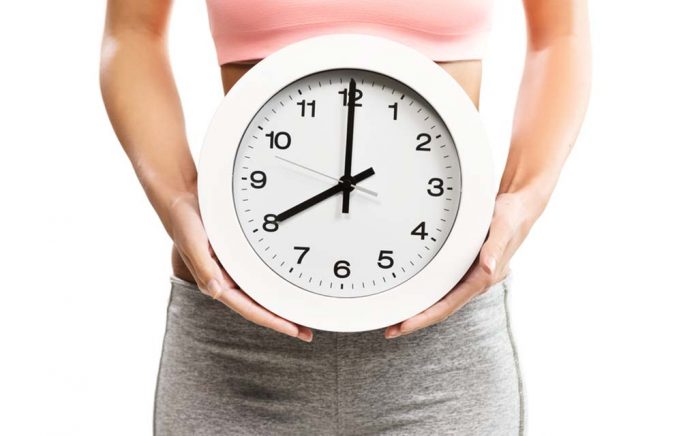
(AscendHealthy.com) – Are you having a hard time losing weight or sleeping at night? The problem might not be just what you’re eating. Instead, it could have something to do with when you’re eating. The Circadian Diet might be the answer. We have the details here.
What Is the Circadian Diet?
When it comes to dieting, we often pay close attention to what we eat, but most of us pay less attention to what time we eat. It turns out that science shows when you eat is just as important as what you’re eating. The Circadian Diet is a nutrition plan that works with your circadian rhythm — or your body’s natural clock.
The circadian rhythm is affected by the sun. It helps us feel awake in the morning and tired at night. Scientists believe that our bodies are controlled by one master clock called the Suprachiasmatic Nucleus (SCN). This main clock controls several smaller body clocks that govern things like our gut, liver and heart.
Circadian rhythms aren’t a new phenomenon, but health experts now believe that eating according to that rhythm can promote wellness and health.
Eating in sync with circadian rhythms may decrease the risk of diabetes, cardiovascular disease and obesity. And the research shows that eating this way may help us lose weight, have more energy and improve our overall health.
Applying the Circadian Diet means paying attention to the sun. The sun is responsible for setting our circadian rhythm. The idea is to eat during daylight hours and fast at night. There is some evidence that suggests the calories consumed in the morning may not count as much as those eaten at night.
An estimated 20-30% of American adults skip breakfast every day. According to the American Heart Association, when we do this we increase our risk of obesity, heart disease and diabetes.
Benefits of the Circadian Diet
Our natural SCN clocks work together with the external environment through cues like when we eat our meals and our exposure to light. The Circadian Diet is basically an eating plan that is time-restricted. It allows us to eat in sync with our internal clocks.
The research shows that people who eat most of their calories early in the day actually lose more weight than people who eat later. This method of eating is called the “When Way.” It calls for you to eat at certain times in the day.
Anyone can benefit from this diet. However, it is particularly great for people with metabolic diseases like type 2 diabetes and obesity. It’s also suitable for people who have a hard time sleeping or cutting down on late-night snacking.
How to Follow the Circadian Diet
Wondering how to follow this diet? Here are some tips:
1. Only Eat During the Day
The sun is our guide. This part of the diet is easy to understand. Eat when the sun is up, and fast when the sun is down. This simple rule could mean faster healing and better sleep. It may also lead to weight loss.
Most people eat over a period of around 15 hours each day. To follow the Circadian Diet, eat only when the sun is up. Try to keep the eating window to 12 hours or less. Ideally, there should be at least 12 hours between the last meal of the day and the first meal of the next day.
This is a form of intermittent fasting, which has been shown to have serious health benefits. If you can increase the fasting period to 14 or 16 hours, it’s even better. A big chunk of that time will be spent sleeping, so it’s not as hard to do as it might sound.
A study in the New England Journal of Medicine found that intermittent fasting did more than just help people to lose weight. It also triggers several cellular functions like increasing metabolism, lowering blood sugar levels and decreases inflammation, which can improve many health conditions from asthma to arthritis. Eating this way also increases brain function and even helps to clear toxins from damaged cells.
2. Eat the Majority of Your Food Early in the Day
This diet calls for loading up calories early in the day. It’s best to eat breakfast within two hours of waking up. Aim for a morning meal that contains protein, healthy fats, vitamins, and fiber. Smoothies are a great choice.
With the Circadian Diet, the earlier you eat, the better. The most significant meal of the day should be breakfast. Dinner will be the smallest meal. Ideally, your goal should be to eat 75% of your calories before 3 p.m.
Dinner should be something light. Try a bowl of black bean soup or salmon. Other great dinner options are avocado toast or a big bowl of salad.
3. Eat Your Normal Dinner Meal for Breakfast
Because breakfast should be the biggest meal of the day, why not try eating your usual dinner meals first thing in the morning? It may take some getting used to, but it could improve your health and wellbeing.
Eating a bowl of whole-grain pasta with salmon for breakfast might sound a little weird, but it’s actually much healthier than eating this meal late in the day. Eating this way may help control hunger and provide more energy throughout the day. Here’s a snapshot of what one day on the Circadian Diet might look like:
- Breakfast: Whole-grain pasta with a chicken breast and vegetables like kale or broccoli
- Lunch: Salmon with vegetables like Brussels sprouts or carrots
- Dinner: A large salad with nuts and seeds and assorted vegetables
Not only might you lose weight on the Circadian Diet, but you may also feel and sleep better. Consult with your healthcare provider before starting any new regimen, but if your doctor sees no obstacles, give it a try for a couple of weeks and see how much better you might feel.
~Here’s to Your Healthy Ascension
Copyright 2023, AscendHealthy.com




















